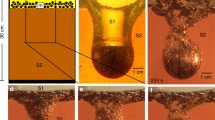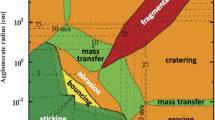Abstract
In this paper, we present a calculation for settling times of grains falling under the action of the gravitational field inside a Jupiter mass protoplanet formed via disk instability, where the grains are assumed to be grown by the process of cold welding. As the energy equation, we have considered the conductive-radiative case of heat transport. In our calculation, we have not used any density model, rather, we have estimated the distribution of physical variables inside the protoplanet. With the obtained distribution of the physical variables, we have investigated the growth of the grains having different initial radii (5 × 10−3- 10−1cm) and hence calculated their sedimentation times. The results are found to be in good agreement with those obtained in other investigations.


Similar content being viewed by others
References
Baines MJ, Williams IP (1965) Growth of interstellar grains. Nature (London) 208:1191–1193
Bodenheimer P, Grossman AS, DeCampli WM, Marcy G, Pollack JB (1980) Calculations of the evolution of the giant planets. Icarus 41:293–308
Boley AC, Hayfield T, Mayer L, Durisen RH (2010) Clumps in the outer disk by disk instability: why they are initially gas giants and the legacy of disruption. Icarus 207:509–516
Boss AP (1997) Giant planet formation by gravitational instability. Science 276:1836–1839
Boss AP (1998a) Evolution of the solar nebula. IV Giant gaseous protoplanet formation Astrophys J 503:923–937
Boss AP (1998b) Formation of extrasolar giant planets: core accretion or disk instability? Earth Moon Planets 81:19–26
Boss AP (2004) Convective cooling of protoplanetary disks and rapid giant planet formation. Astrophys J 610:456–463
Boss AP (2007) Testing disk instability models for giant planet formation. Astrophys J 661:L73–L76
Birnstiel T, Dullemond CP, Brauer F (2010) Gas-and dust evolution in protoplanetary disks. Astron Astrophys 513:A79
Cha SH, Nayakshin S (2011) A numerical simulation of a ‘super-Earth’core delivery from ∼100 AU to ∼8 AU. MNRAS 415:3319–3334
Dodson-Robinson SE, Veras D, Ford EB, Beichman CA (2009) The formation mechanism of gas giants on wide orbits. Astrophys J 707:79–88
Helled R, Kovetz A, Podolak M (2005) Settling of small grains in an extended protoplanet. Bull Am Astron Soc 37:675
Helled R, Podolak M, Kovetz A (2008) Grain sedimentation in a giant gaseous protoplanet. Icarus 195:863–870
Helled R, Schubert G (2008) Core formation in giant gaseous protoplanets. Icarus 198:156–162
Helled R, Bodenheimer P (2011) The effects of metallicity and grain growth and settling on the early evolution of gaseous protoplanets. Icarus 211:939–947
Hubickyj O, Bodenheimer P, Lissauer JJ (2005) Accretion of the gaseous envelope of Jupiter around a 5-10 earth-mass core. Icarus 179:415–431
Lissauer JJ (1993) Planet formation. Annu Rev Astron Astrophys 31:129–172
Kalas P, Graham JR, Chiang E, Fitzgerald MP, Clampin M, Kite ES, Stapelfeldt K, Marois C, Krist J (2008) Optical images of an exosolar planet 25 light-years from earth. Science 322:1345–1348
Marois C, Macintosh B, Barman T, Zuckerman B, Song I, Patience J, Lafrenière D, Doyon R (2008) Direct imaging of multiple planets orbiting the star HR 8799. Science 32:1348–1352
McCrea WH, Williams IP (1965) Segregation of materials in cosmogony. Proc Roy Soc 287:143–164
Mizuno H (1980) Formation of the giant planets. Progr Theor Phy 64:544–557
Nayakshin S (2010) Formation of planets by tidal downsizing of giant planet embryos. MNRAS 408:L36–L40
Paul GC, Pramanik JN, Bhattacharjee SK (2008) Structure of initial protoplanets. Int J Mod Phys A 23:2801–2808
Paul GC, Bhattacharjee SK, Pramanik JN (2011) Grain sedimentation time in a gaseous protoplanet. Earth Moon Planets 108:87–94
Paul GC, Datta S, Pramanik JN, Rahman MM (2012a) Dust grain growth and settling in initial gaseous giant protoplanets. Earth Planets Space 64:641–648
Paul GC, Pramanik JN, Bhattacharjee SK (2012b) Gravitational settling time of solid grains in gaseous protoplanets. Acta Astronaut 76:95–98
Paul GC, Rahman MM, Kumar D, Barman MC (2013) The radius spectrum of solid grains settling in gaseous protoplanets. Earth Sci Inform 6:137–144
Paul GC, Senthilkumar S (2016) Execution of novel explicit RKARMS (4, 4) technique in determining initial configurations of extra-solar protoplanets formed by disk instability. NRIAG J Astron Geophysics 5:1–8
Podolak M, Pollack JB, Reynolods RT (1988) Interactions of planetesimals with protoplanetary atmospheres. Icarus 73:163–179
Pollack JB, Hubickyj O, Bodenheimer P, Lissauer JJ, Podolak M, Greenzweig Y (1996) Formation of the giant planets by concurrent accretion of solids and gas. Icarus 124:62–85
Safronov VS (1969, 1972) evolution of the protoplanetary cloud and formation of the earth and planets, Moscow, Nauka, in Russian, English translation: NASA-TTF-677. Israel Sci. Transl, Jerusalem
Williams IP, Crampin DJ (1971) Segregation of material with reference to the formation of the terrestrial planets. MNRAS 152:261–275
Williams IP, Handbury MJ (1974) Segregation of the heavy elements in the solar systems. Astrophys Space Sci 30:215–223
Weidenschilling SJ (1984) Evolution of grains in a turbulent solar nebula. Icarus 60:553–567
Wuchterl G, Guillot T, Lissauer JJ (2000) In: Mannings V, Boss AP, Russell SS (eds) Protostars and planets IV. University of Arizona Press, Tucson 1081
Acknowledgments
The authors are grateful to the two anonymous referees for their insightful comments and useful suggestions for improving the manuscript. The first author would like to thank Professor Shishir Kumar Bhattacharjee (Retd.), Department of Mathematics, University of Rajshahi, and Professor Iwan P. Williams, Queen Mary University of London, School of Physics and Astronomy for their help in deducing the heat transport equation used in the study.
Author information
Authors and Affiliations
Corresponding author
Ethics declarations
Conflict of interest
The authors declare that there is no conflict of interest regarding the publication of this article.
Additional information
Communicated by: H. Babaie
Publisher’s note
Springer Nature remains neutral with regard to jurisdictional claims in published maps and institutional affiliations.
Rights and permissions
About this article
Cite this article
Paul, G.C., Farjana, B., Ali, M.E. et al. Segregation of heavy elements in an initial protoplanet. Earth Sci Inform 13, 893–899 (2020). https://doi.org/10.1007/s12145-020-00474-5
Received:
Accepted:
Published:
Issue Date:
DOI: https://doi.org/10.1007/s12145-020-00474-5




